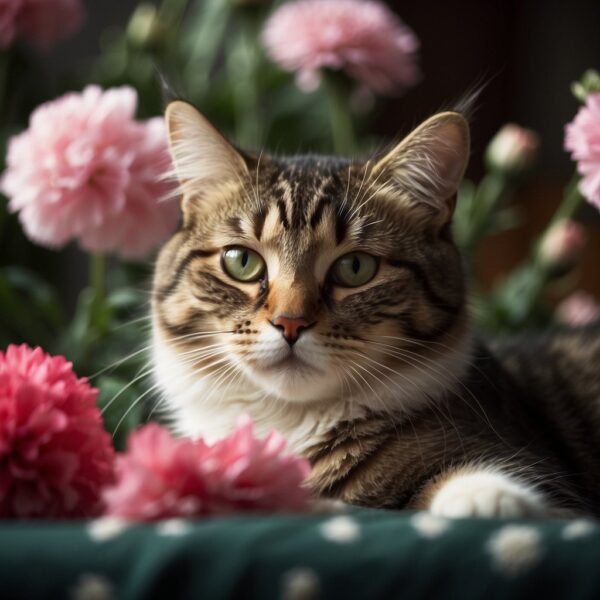
Carnations are toxic to Cats
Carnations, while popular for their vibrant colors and enduring blooms, pose a health risk to cats. Carnations are poisonous to cats. These flowers contain substances that are toxic to cats, dogs, and horses. When ingested, carnations can cause a number of unpleasant symptoms in felines that range from gastrointestinal upset to skin irritation. Although they are not considered as deadly as some other plants, it’s important for cat parents to recognize the potential dangers and take steps to keep these flowers out of reach.
Understanding the specifics of carnation toxicity is crucial for cat parents. It’s the saponins in carnations that are likely to blame for the toxicity. Symptoms of exposure can include mild gastrointestinal signs such as vomiting or diarrhea and sometimes dermatitis. These symptoms are typically not life-threatening and often resolve with minimal treatment, but they are uncomfortable for the animal and can be distressing for the guardian. Thus, prevention and prompt action if exposure occurs are key to ensuring the safety and well-being of household pets.
Key Takeaways: Carnations are poisonous to cats
- Carnations are toxic to cats, causing symptoms like gastrointestinal upset and skin irritation.
- The toxicity is generally mild, with serious complications being rare for felines.
- Preventative measures and knowing how to respond to exposure are essential for cat safety.
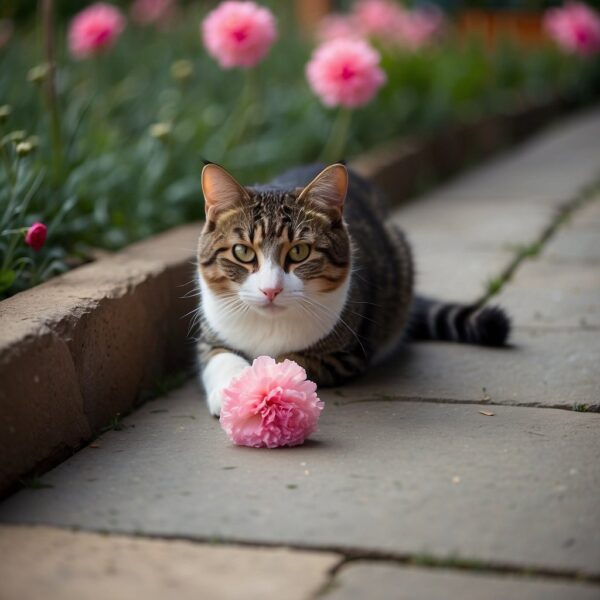
Carnation Toxicity
Carnations, while aesthetically pleasing, pose a risk to cats due to their mild toxicity, which can lead to various symptoms like gastrointestinal upset and dermatitis.
Are Carnations Toxic to Cats?
Carnations (Dianthus caryophyllus) are poisonous to cats and contain an unknown irritant that is toxic to cats. The entire plant, including petals, leaves, and stem, possesses compounds that can cause negative health effects if ingested by felines. This toxicity is not exclusive to carnations; several household plants can pose similar risks.
Potential Risks and Symptoms
When a cat ingests parts of a carnation, the main compounds of concern are triterpenoid saponins. These can lead to a range of symptoms, primarily centered around gastrointestinal upset. Common symptoms include:
- Vomiting
- Diarrhea
- Stomach discomfort
In addition to these internal symptoms, external signs of irritation, such as dermatitis, may also appear. If a cat exhibits these symptoms, it is advisable to consult a veterinarian promptly.
Comparing Toxicity in Cats, Dogs, and Other Animals
Carnation toxicity is not limited to cats. It extends to other domestic animals, including dogs and horses. Each species may react differently to the plant’s irritant:
| Animals | Reaction to Carnations |
|---|---|
| Cats | Gastrointestinal upset, dermatitis |
| Dogs | Similar to cats, but may vary |
| Horses | Toxicity symptoms possible |
| Other Animals | Dependent on species |
While the toxic principle in carnations is consistent, the degree of toxicity and the resulting symptoms can differ among cats and other animals, with some potentially being more sensitive than others.
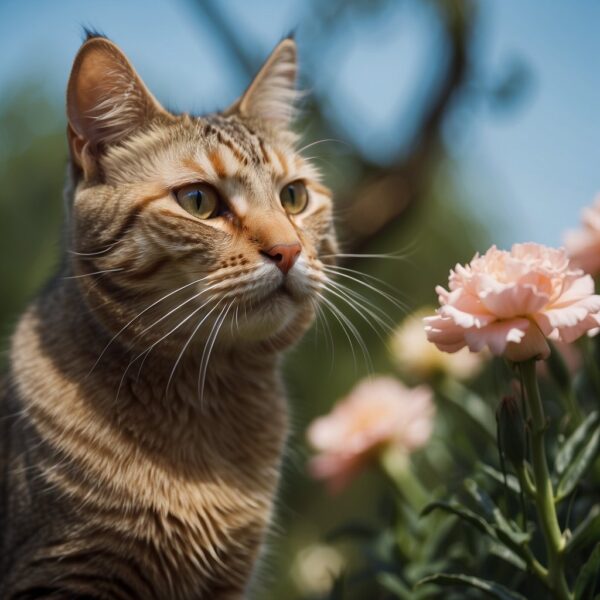
Carnations are poisonous to cats: Exposure and Symptoms
This section will discuss how cats come into contact with carnations and the symptoms they may exhibit as a result of this exposure. Understanding these factors is crucial for cat parents to prevent poisoning and to recognize the need for prompt veterinary care when necessary.
How Cats Are Exposed to Carnations
Cats can be exposed to carnations when they come into contact with the sap, stem, or leaves of the plant, which contain triterpenoid saponins. These components can be toxic to cats if consumed. Since felines are curious by nature and may nibble on accessible plants, it is important to keep carnations out of a cat’s reach.
Clinical Signs of Carnation Poisoning in Cats
Carnations are poisonous to cats. When a cat ingests parts of a carnation plant, it may exhibit various clinical signs that indicate poisoning. The severity of the symptoms can vary, but commonly observed signs include:
- Vomiting
- Diarrhea
- Loss of appetite
- Excessive drooling
These symptoms can lead to dehydration if not properly addressed. If you observe such signs, consult a veterinarian as they may need to induce vomiting or administer other treatment to aid in recovery.
Long-Term Effects and Severity
The long-term effects of carnation poisoning in cats are generally not severe due to the plant’s mild toxicity level. However, repeated exposure or consumption in large amounts can lead to more serious conditions such as kidney failure. A prompt and appropriate treatment plan is crucial for the cat’s recovery and to minimize any potential long-term effects.
Understanding Carnations
Carnations, known for their vibrant colors and ruffled petals, are a mainstay in horticultural displays and floral arrangements. Their popularity and beauty often evoke curiosity about their classification and potential effects within the plant kingdom.
What Are Carnations?
Carnations, scientifically known as Dianthus caryophyllus, are flowering plants that possess a distinctive fragrance and a plethora of color variations. Native to the Mediterranean region, they have been cultivated for centuries for their ornamental value. The term “carnation” is derived from “coronation” or “corone,” referring to floral garlands; this etymology reflects their historical use in Greek ceremonial crowns.
Carnation Varieties and Common Names
The carnation family spans numerous varieties, often differentiated by flower size, color, and pattern. Some common types include:
- Standard Carnations: These are the large, single-bloom varieties often seen in flower shops.
- Spray Carnations (Mini Carnations): Smaller and bushier, these have multiple smaller flowers per stem.
- Dwarf Flowered Carnations: Compact in size with numerous small flowers, ideal for ground cover.
Beyond the basic segmentation, carnations may also go by colloquial names, such as pinks, due to their pinkish hues and frilled edges resembling pinking shears, as well as Sweet William, another member of the Dianthus genus.
Carnations and the Caryophyllaceae Family
Carnations are a prominent member of the Caryophyllaceae family, a diverse group encompassing more than 2,000 species across 88 genera. The family Caryophyllaceae is also known as the pink or carnation family and includes plants that are mostly herbaceous in nature. It’s a family characterized by oppositely arranged leaves and often with swollen node joints. Within this family, the genus Dianthus stands out, and it includes not only carnations but also the wild pinks, offering a rich variety of species well-adapted to various environments, from the garden varieties cultivated globally to the wild carnations found throughout their native range.
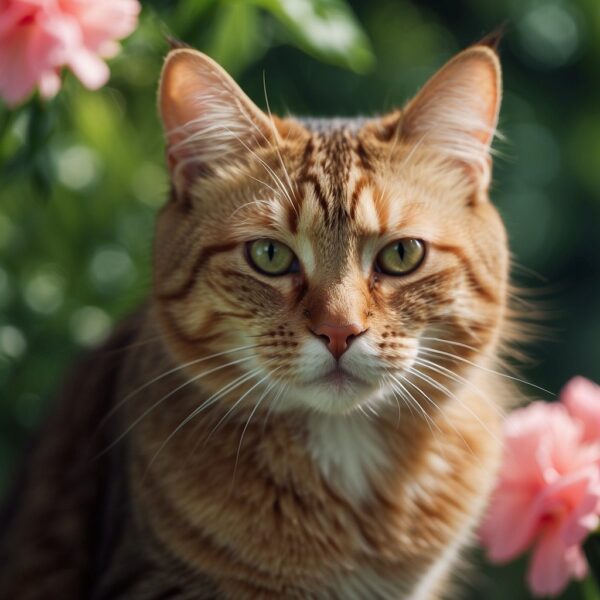
Carnations poisonous to cats: Prevention and Safety
When it comes to keeping feline companions safe from potentially harmful plants, such as carnations, prevention plays a pivotal role. It is important to create a secure environment, opt for non-toxic plant alternatives, and implement strategies to protect both the cats and the plants.
Creating a Safe Environment for Cats
For cat parents, safeguarding their cats against toxic plants involves maintaining a vigilant approach to which flora are accessible within the home. The use of high shelves or enclosed spaces can effectively keep curious cats away from carnations and other potential threats. Additionally, cat parents may consider designating an area with cat grass, a safe and beneficial alternative that not only satisfies a cat’s urge to chew on vegetation but also provides a nutritious option.
Non-Toxic Plant Alternatives
When replacing or choosing houseplants, one should prioritize those that have been identified as non-toxic to cats. Plants such as roses, marigolds, sunflowers, and orchids are appealing and safe flowers that make for cat-friendly houseplants. Providing these non-toxic options reduces the risk to pets and adds natural beauty to the living space without causing undue stress to pet owners.
- Safe Houseplant Alternatives:
- Roses
- Marigolds
- Sunflowers
- Orchids
Protecting Carnations from Cats
In cases where carnations are present, creating a physical barrier with chicken wire or similar materials can deter cats from reaching the plants. This not only preserves the well-being of the pets by preventing ingestion but also protects the aesthetic value of the flowers. For outdoor gardens, it can be beneficial to ensure that the areas where carnations and other toxic plants grow are not accessible by pets and local wildlife, establishing a secure perimeter for play and exploration.
Implementing these preventative measures helps in creating a safe and enjoyable environment for both cats and their guardians.
Treatment and First Aid
When a cat consumes carnations, immediate attention is required due to potential toxins that may cause stomach irritation and vomiting. Seeking a veterinarian’s expertise is crucial for diagnosis and formulating a treatment plan to facilitate recovery.
Immediate Actions After Consumption
Upon discovering that a cat has ingested carnations, prompt measures should be taken to minimize absorption of the plant’s toxins. These actions include:
- Rinse the mouth: If there’s evidence of skin irritation around the mouth, gently rinsing the area with water can help remove plant residue that may cause further irritation.
- Withhold food: To ease the stomach and esophagus, it is advisable to temporarily withhold food to prevent further vomiting.
Veterinarian Intervention and Diagnosis
A veterinarian should be consulted immediately after a cat has been exposed to carnations. In the clinical setting:
- Clinical Assessment: The veterinarian will perform a thorough examination to assess the severity of symptoms and possible skin irritation.
- Diagnostic Tests: They might undertake tests such as blood work or imaging to understand the extent of intoxication.
Remedies and Recovery after Cat eats Carnations
After a veterinarian visit, the following treatments and supportive measures may be recommended for recovery:
- Offer fluids: To keep the cat hydrated and soothe the esophagus, bland liquids such as tuna juice or chicken broth might be suggested.
- Medications: Depending on the diagnosis, the veterinarian may prescribe medications to alleviate stomach irritation and control vomiting.
A well-structured treatment plan, created in conjunction with veterinarian research and knowledge, increases the likelihood of a swift and complete recovery.
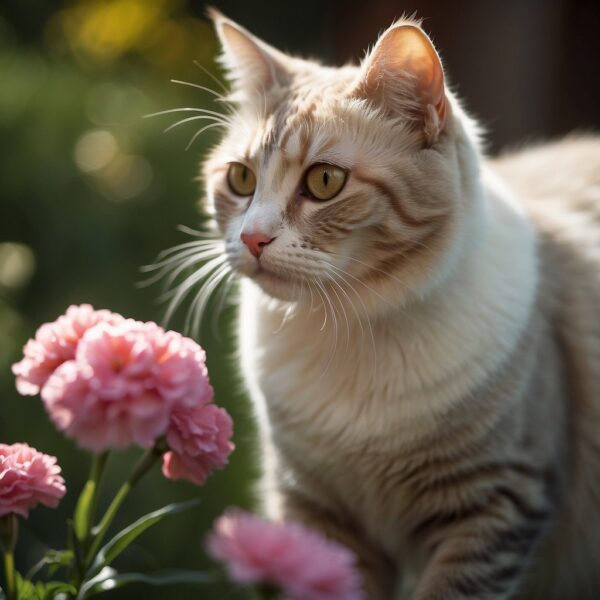
Frequently Asked Questions
Carnations are poisonous to cats. This section addresses common concerns about the effects of carnations on cats, appropriate responses to ingestion, identifies harmful and safe flowers for cats, and explains the toxicity levels of different plants.
What symptoms occur if a cat ingests carnations?
If a cat ingests carnations, they may exhibit symptoms like gastrointestinal upset, vomiting, diarrhea, and possibly skin irritation due to the triterpenoid saponins present in the plant.
How should one respond if a cat eats part of a carnation?
Upon noticing that a cat has eaten a part of a carnation, one should monitor the cat for any signs of distress and consult a veterinarian for advice. It may be necessary to provide professional medical attention to alleviate the symptoms.
Which common household flowers are harmful to cats?
Common household flowers that are harmful to cats include lilies, tulips, azaleas, chrysanthemums, and amaryllis. These can cause a range of symptoms from mild gastrointestinal upset to severe, sometimes life-threatening conditions.
What non-toxic floral options can cat owners safely display?
Cat owners can safely display non-toxic flowers such as roses, sunflowers, snapdragons, and violets. These plants are considered safe and should not pose a threat if a curious cat nibbles on them.
In what ways are daisies and carnations similar regarding feline safety?
Daisies and carnations are similar regarding feline safety in that both can cause mild gastrointestinal upset if ingested. They contain substances that are mildly toxic to cats but are generally not life-threatening.
What makes certain flowers more dangerous to cats than others?
Certain flowers are more dangerous to cats than others due to the presence of specific toxins, such as lycorine, cardiac glycosides, or alkaloids, which affect the cat’s organ systems more profoundly and can lead to severe health issues or even death.